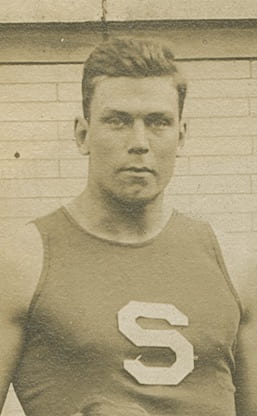- NUMBER OF PENN STATERS COMPETING: 2
- NUMBER OF PENN STATERS IN ALL ROLES: 2
- NUMBER OF OLYMPIC ALTERNATES: 0
Nate Cartmell made his second appearance for the U.S. Olympic track and field team in 1908, claiming a gold medal in the 4×400-meter relay and bronze in the 200-meter race. During the same Olympics in London, Penn State’s first alumnus also joined the track and field team and also competed in wrestling and the tug of war competition that existed in early editions of the Olympics.
Profile: Lee Talbott

Lee Talbott began his college career as the most heralded high-school athlete coming out of Missouri. The multi-sport star and son of Kansas City’s mayor originally chose to attend Cornell, where he spent two years from 1907 to 1909. During his time in Ithaca, Talbott won the Amateur Athletic Union national championship in the hammer throw. Talbott was in the midst of his Big Red career when he traveled across the Atlantic to face off against the world’s best throwers in the discus, shot put, and hammer throw at the London Olympics. The college thrower’s best finish was fifth in the hammer throw, and he also finished in the top ten of his other throwing events. In addition to his exploits in the field, Talbott also helped the United States to a fifth-place finish in the tug of war competition and finished ninth in the heavyweight division of the wrestling tournament.
A year after his Olympic exploits, Talbott transferred from Cornell to Penn State for his final two years of undergraduate study. While in State College, Talbott broke school records in the shot put and discus during the 1910 season. He also set a new collegiate record in the hammer throw with a toss of 173 feet, 6 inches, beating the previous record of 164 feet, 10 inches.
After graduating from Penn State, Talbott returned to Kansas City where he worked as a regional sales representative for the National Tile Silo Company and continued to compete in throwing events for the Kansas City Athletic Club into his early thirties. The 1908 Olympics proved his only opportunity to compete on the world’s biggest stage. He sat out the 1912 Olympics as he started his career, but by 1916 Talbott was ready to compete for an Olympic spot once again. World War I led to the cancellation of the 1916 Berlin Olympics, though, and Talbott ended his competitive throwing career a year later.
SOURCES AND ADDITIONAL READING
- “Craig and Talbott Broke Records,” Kansas City (MO) Times, September 3, 1912, 9.
- Kraenzlein, Alvin C. “Athletes of 10 Years Ago and Those of Today.” Boston (MA) Globe, March 26, 1911, 57.
- “Lee J. Talbott Dies,” Kansas City (MO) Star, September 17, 1954, 37.
- “Lee Talbott to Penn State,” Kansas City (MO) Star, November 11, 1909, 8.
- “Olympic Athlete Was Here,” Hutchinson (KS) News, April 25, 1914, 3.
- “Talbott is Real Star,” St. Louis (MO) Globe-Democrat, June 9, 1907, S3.

